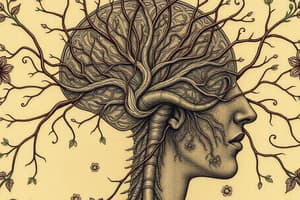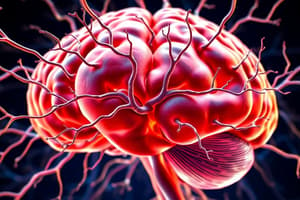Podcast
Questions and Answers
What is the primary function of the sensory division of the peripheral nervous system?
What is the primary function of the sensory division of the peripheral nervous system?
- Process and interpret stimuli.
- Gather information from peripheral receptors. (correct)
- Carry impulses from the central nervous system to muscles.
- Regulate functions by secreting hormones.
How many pairs of cranial nerves are there in the human body?
How many pairs of cranial nerves are there in the human body?
- 14 pairs
- 10 pairs
- 15 pairs
- 12 pairs (correct)
What are the two main systems that regulate the functions of the body?
What are the two main systems that regulate the functions of the body?
- Central and peripheral nervous systems
- Afferent and efferent divisions
- Sympathetic and parasympathetic systems
- Nervous and endocrine systems (correct)
What is the primary function of the Central Nervous System (CNS)?
What is the primary function of the Central Nervous System (CNS)?
Which part of the nervous system is made up of the brain and spinal cord?
Which part of the nervous system is made up of the brain and spinal cord?
Which structure is part of the Peripheral Nervous System (PNS)?
Which structure is part of the Peripheral Nervous System (PNS)?
What is the role of motor output in the nervous system?
What is the role of motor output in the nervous system?
What is the main role of the sensory (afferent) division?
What is the main role of the sensory (afferent) division?
How many segments form the spinal cord?
How many segments form the spinal cord?
Which of the following receptors belongs to the sensory division?
Which of the following receptors belongs to the sensory division?
Which division of the nervous system is responsible for involuntary control of organs?
Which division of the nervous system is responsible for involuntary control of organs?
How does the sympathetic division function in the body?
How does the sympathetic division function in the body?
What classification of nerves arises from the spinal cord?
What classification of nerves arises from the spinal cord?
What component of the reflex arc receives stimuli and initiates the reflex action?
What component of the reflex arc receives stimuli and initiates the reflex action?
What defines a polysynaptic reflex?
What defines a polysynaptic reflex?
Which nervous system component is responsible for voluntary muscle control?
Which nervous system component is responsible for voluntary muscle control?
What neurotransmitter is released from the postganglionic neuron in the sympathetic division of the autonomic nervous system?
What neurotransmitter is released from the postganglionic neuron in the sympathetic division of the autonomic nervous system?
Which of the following accurately describes the structure of the autonomic nervous system?
Which of the following accurately describes the structure of the autonomic nervous system?
What is the primary role of the autonomic ganglia?
What is the primary role of the autonomic ganglia?
Which cranial nerves are involved in the parasympathetic division of the autonomic nervous system?
Which cranial nerves are involved in the parasympathetic division of the autonomic nervous system?
In somatic efferent innervation, which neurotransmitter is responsible for muscle contraction?
In somatic efferent innervation, which neurotransmitter is responsible for muscle contraction?
What differentiates the preganglionic neurons from postganglionic neurons in the autonomic system?
What differentiates the preganglionic neurons from postganglionic neurons in the autonomic system?
Which type of ganglia is associated with the sympathetic chain?
Which type of ganglia is associated with the sympathetic chain?
Which statement accurately describes the autonomic nervous system?
Which statement accurately describes the autonomic nervous system?
What neurotransmitter is primarily used by postganglionic neurons in the sympathetic division?
What neurotransmitter is primarily used by postganglionic neurons in the sympathetic division?
Where are terminal ganglia primarily located?
Where are terminal ganglia primarily located?
Which of the following correctly describes the length of preganglionic fibers in the sympathetic division?
Which of the following correctly describes the length of preganglionic fibers in the sympathetic division?
What is a function of autonomic ganglia?
What is a function of autonomic ganglia?
Which segment of the spinal cord contains preganglionic neurons for the sympathetic division?
Which segment of the spinal cord contains preganglionic neurons for the sympathetic division?
What is a characteristic of postganglionic neurons in the parasympathetic division?
What is a characteristic of postganglionic neurons in the parasympathetic division?
Which of the following statements about the chemical transmission in autonomic ganglia is true?
Which of the following statements about the chemical transmission in autonomic ganglia is true?
What is the primary role of collateral ganglia in the autonomic nervous system?
What is the primary role of collateral ganglia in the autonomic nervous system?
Flashcards are hidden until you start studying
Study Notes
Introduction
- The nervous system and endocrine system regulate body functions.
- The nervous system is a rapid control system using nerve impulses.
- The endocrine system is a slower control system using hormones.
Functions of the Nervous System
- Gathers information about changes inside and outside the body (stimuli).
- Processes and interprets sensory input, deciding if action is needed.
- Activates muscles or glands in response to stimuli.
Organization of the Nervous System
Anatomical divisions
- Central nervous system (CNS): brain and spinal cord
- Brain: cerebrum, cerebellum, brain stem (midbrain, pons, medulla oblongata)
- Spinal cord: 31 segments (8 cervical, 12 thoracic, 5 lumbar, 5 sacral, 1 coccygeal)
- Peripheral nervous system (PNS): nerves extending from the brain and spinal cord
Divisions based on origin
- Cranial nerves: 12 pairs arising from the brain.
- Spinal nerves: 31 pairs arising from the spinal cord, one pair per segment.
Functional Classification of the Peripheral Nervous System (PNS)
- Sensory (afferent) division: carries information from receptors to the CNS.
- Includes visual, auditory, chemoreceptors, and somatosensory (touch) receptors.
- Motor (efferent) division: carries impulses from the CNS to peripheral organs.
Central Nervous System (CNS)
- Structure: Brain and spinal cord
- Function: Integrative and control centers
Peripheral Nervous System (PNS)
- Structure: Cranial nerves and spinal nerves
- Function: Communication lines between the CNS and the rest of the body
Sensory (afferent) Division
- Structure: Somatic and visceral sensory nerve fibers
- Function: Conducts impulses from receptors to the CNS
Motor (efferent) Division
- Structure: Motor nerve fibers
- Function: Conducts impulses from the CNS to effectors (muscles and glands)
Autonomic Nervous System (ANS)
- Structure: Visceral motor (involuntary)
- Function: Conducts impulses from the CNS to cardiac muscles, smooth muscles, and glands
Sympathetic Division
- Function: Mobilizes body systems during activity ("fight or flight").
Parasympathetic Division
- Function: Conserves energy, promotes "housekeeping" functions during rest.
Somatic Nervous System
- Structure: Somatic motor (voluntary)
- Function: Conducts impulses from the CNS to skeletal muscles.
Physiological divisions
- Somatic nervous system: controls voluntary skeletal muscle movements.
- Autonomic nervous system: regulates involuntary visceral functions (heart, lungs, kidneys, GIT, bladder, sexual organs, glands).
Structural and Functional Unit of the Nervous System
- Neuron: the structural unit of the nervous system.
- Reflex action (arc): the functional unit of the nervous system.
- An involuntary, inborn response to a stimulus.
Reflex Arc
- Polysynaptic Reflex: involves more than one synapse.
Components
- Receptor: sensitive structure responding to changes in internal/external environments.
- Afferent neuron: carries impulses from receptors to the CNS.
- Center: located within the CNS.
- Efferent neuron: conducts impulses from the CNS to the effector organ.
- Effector organ: skeletal muscle, smooth muscle, cardiac muscle, or gland.
Somatic Efferent Innervation
- Single myelinated nerve fiber travels from CNS to the effector organ.
- Neurotransmitter: acetylcholine (ACh), causing muscle contraction.
Autonomic Efferent Innervation
- Two neurons involved:
- Preganglionic neuron: originates in the CNS, travels to an autonomic ganglion.
- Postganglionic neuron: originates in the autonomic ganglion, travels to the effector organ.
- Preganglionic neurotransmitter: always acetylcholine (ACh).
- Postganglionic neurotransmitter: varies depending on the division:
- Sympathetic: norepinephrine (NE).
- Parasympathetic: acetylcholine (ACh).
Autonomic Nervous System
- Two neurons in series connect the CNS and effector cells.
- Synapse occurs in autonomic ganglia, outside the CNS.
- Preganglionic fibers: between CNS and ganglia.
- Postganglionic fibers: between ganglia and effector cells.
Divisions of the Autonomic Nervous System
- Sympathetic nervous system (Thoracolumbar outflow): arises from T1-L2 spinal cord segments.
- Parasympathetic nervous system (Cranio-sacral outflow): arises from cranial nerves III, VII, IX, X, and sacral segments S2-S4.
Autonomic Ganglia
- Group of neuron cell bodies outside the CNS.
- Site of contact between pre and postganglionic fibers.
Types
- Lateral/paravertebral ganglia (sympathetic chain):
- Lie on either side of the vertebral column.
- Relay sympathetic fibers to the head, neck, and thoracic viscera.
- Prevertebral/collateral ganglia:
- Lie between the sympathetic chain and the organ of supply.
- Relay preganglionic sympathetic fibers to the abdomen and pelvis.
- Examples: celiac, superior mesenteric, inferior mesenteric ganglia.
- Terminal ganglia (parasympathetic):
- Near or within the innervated organs.
- Relay all parasympathetic fibers.
Functions of Autonomic Ganglia
- Relay preganglionic fibers from the CNS.
- Distribute signals: each preganglionic axon diverges to many postganglionic neurons.
- Neurotransmitter: acetylcholine (ACh).
Table: Comparison of Sympathetic and Parasympathetic Divisions
| Feature | Sympathetic Division | Parasympathetic Division |
|---|---|---|
| Location of preganglionic neuron | Thoracolumbar spinal cord | Cranial nerve nuclei and sacral spinal cord |
| Location of postganglionic neuron | Away from target organ | Near or in the target organ |
| Length of preganglionic fibers | Short | Long |
| Length of postganglionic fibers | Long | Short |
| Preganglionic neurotransmitter | Acetylcholine | Acetylcholine |
| Postganglionic neurotransmitter | Noradrenaline | Acetylcholine |
Comparison of Somatomotor and Autonomic Nervous Systems
- Somatomotor: Single neuron from spinal cord to effector organ.
- Autonomic: Synapse between neuron leaving spinal cord and effector organ (except adrenal medulla).
- All neurons leaving the CNS release acetylcholine (ACh).
Conclusion
- The autonomic nervous system plays a crucial role in regulating vital bodily functions.
- Understanding the ANS is essential for comprehending physiological processes such as heart rate, blood pressure, digestion, and breathing.
Studying That Suits You
Use AI to generate personalized quizzes and flashcards to suit your learning preferences.



